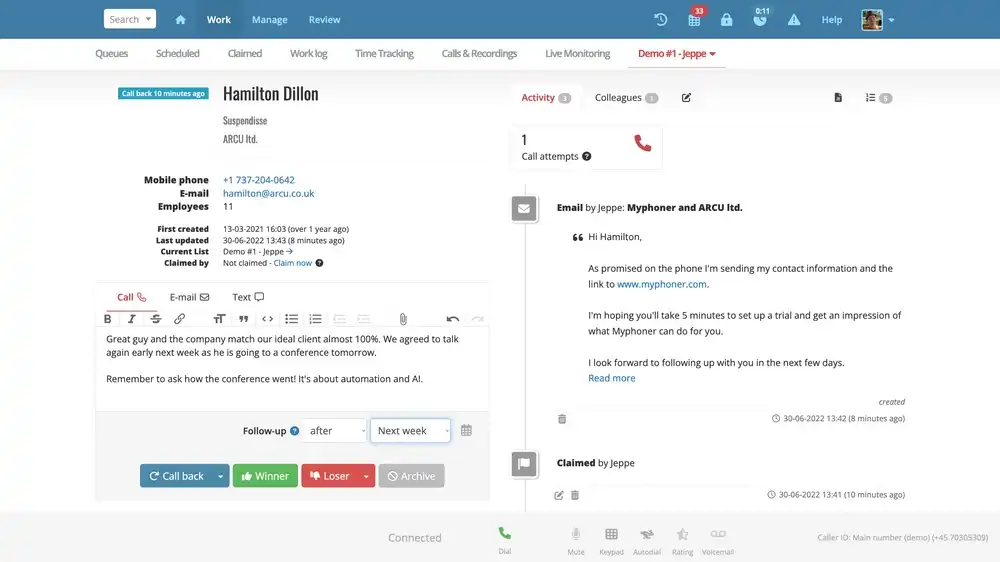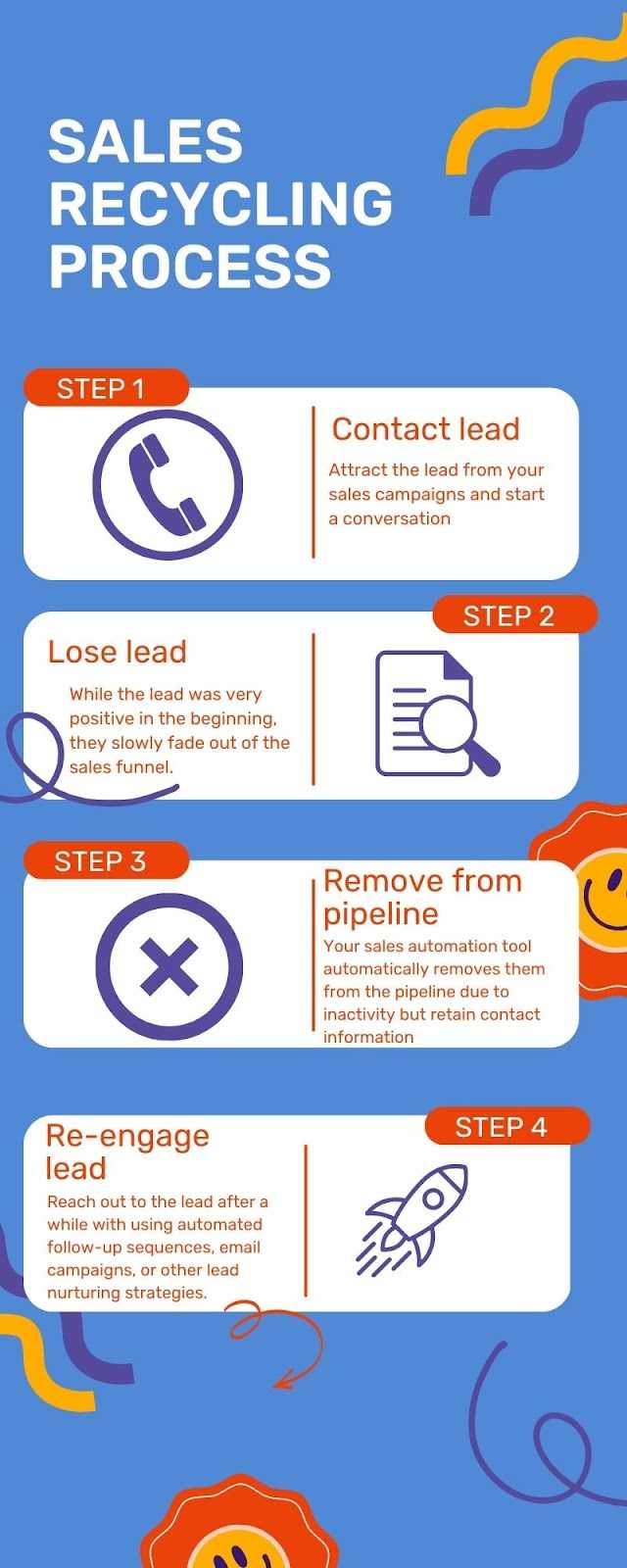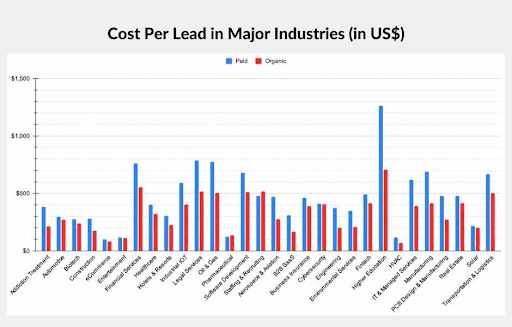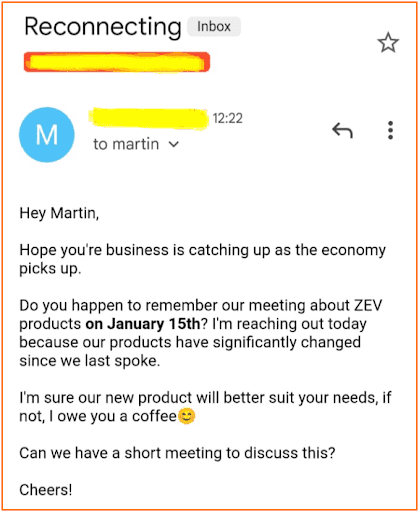Lead Recycling 101: Turn Old Leads Into Paying Customers

- June 1, 2023
Your cold-calling campaign was successful.
You got John as a promising lead. He was very interested and ready to take the conversation further.
He met your ideal customer profile (ICP), and you’re sure your product will streamline his company’s operational efficiency.
John is about to make that final decision, but as we all know, B2B purchase decisions tend to take a bit longer. He has to consult first with key decision-makers in his company.
But all of a sudden, John goes silent. He’s leaked out of the sales funnel, and you don’t get his feedback.
I’m sure you have experienced this as it’s common in sales. But most SDRs make the mistake of counting it as a lost lead and start the whole process again with a new prospect.
This hints that you may be spending far more time and money on acquiring leads than converting them into paying customers.
Enter sales lead recycling and re-engaging old leads.
What is Sales Lead Recycling?
As the word “recycle” hints, sales lead recycling is simply reaching out to the old prospects that once had shown interest in your product but leaked out of the sales funnel.
Quick pause to highlight Myphoner. Don't worry, your article resumes below.
Selling to undefined over the phone?
Use our sales dialer to call customers and prospects in undefined at the most competitive rates

Let’s use the example above to see the phases of lead recycling.
You reached out to John, he was a potential customer, but he went silent. You then removed him from your sales pipeline.
However, you later decided to catch up with him again to see if he might be interested in continuing the conversation.
Here’s an infographic.

Sales recycling and re-engagement aim to start a new conversationbacked by high-quality content to regain their trust.
Prospects fade out of the sales funnel due to bad timing, budgeting limits, or even getting replaced by a new employee in their department.
For example, during the pandemic, many companies were into cutting costs and couldn’t commit to new business relationships.
But the economy is slowly returning to "normal" as the years go by,, and businesses are slowly opening up. This means the leads you contacted during the pandemic might now be sales-ready.
Why is Sales Lead Recycling Important?
Sales lead recycling has many benefits, as follows:
Saving on costs
This data from the US-based marketing firm, “First Page Sage”, shows a graph with the average acquisition cost per lead of multiple industries in the USA.

The average cost per lead across all industries is between $200 - $700.
Let’s assume your company sells an IT service to accounting firms, and you decide to use paid ads to get leads; your cost per lead will be $600. If you’re targeting 100 clients per month, your total lead acquisition cost would be $60,000.
That’s not sustainable because the cost is still incurred regardless of the eventual outcome of the discussion.
Lead recycling cuts costs significantly. You don’t have to spend more time and money starting the lead acquisition process from scratch.
Why?
You already have a database of potential leads with their contact information. That means you’ve already covered half of the lead acquisition process.
Time-saving
It takes eight call attempts and six cold emails when sourcing leads using outbound methods, while organic channels will take 6 - 9 months before you may see something flourish.
Either way, the time for both options doesn’t fit companies that want to capture leads quickly. Recycle and re-engage old leads instead of going through the above cycle, which wastes time.
Leads are more sales-ready
Leads say no to a product on the first contact with SDR for many reasons.One of which is they might not be “sales-ready.”
In simple terms,“not being sales-ready” means that the lead wasn’t highly interested in your product when youinitially contacted them.
This could be because you either reached out too early when they hadn't developed a need for the product yet, or too late and they chose to opt for a competitor.
However, time changes things.They might find issues with their first choice and regret their decision.Or their situation might have escalated, and they need your product or service now.Either way, it’s the perfect time to strike.
Steps to Recycling Lost Prospects
Recycling lost leads is a no-brainer because you’re not following the sales funnel top-down.Here is the simple step-by-step process:
1. Determine the “when” and the “where”
You probably use CRM tools to keep track of all the leads that start the buyer journey in your sales funnel. This means you can quickly determine where and when you lost the prospects.
Saleshacker published a case study of SISU, a Real Estate team operating system, on how they did their sales recycling process. The first thing they did was to determine the origin of the recycling sequence.
“In a last-ditch effort, we came up with a plan: get in touch with people who took a demo 6+ months ago who said no at the time, and haven’t heard from us in at least four months,” said Zac Muir, the VP of sales and Marketing at SISU.
Once they had discovered the “when,” the next question was to get the “where.” Luckily for SISU,they built a robust system(with the help of Salesforce) to know the stage at which a lead was.
Zac says that they set demos as an events object, and the events are coded by type with the date the demo was held.
Therefore, if the person is still a lead, they’ll know he’s on the demo and is not converted. They’ll then pick those contacts ready for a new campaign.
You don't have to mimic their strategy; every company is different.But the goal is to analyze your sales sequence to determine the stage where most leads disappear. Once done, collect those leads and their contacts.
2. Ramp up your content production
Purchasing in B2B isn’t as easy as in B2C.
The former spend up to90% of their buying journey educating themselves before pulling out their credit cards.
And one of the reasons why leads faze out of the sales funnel is because of irrelevant or non-convincing content. A mistake most B2B companies make is creating content because “content marketing is important.”
They don’t have a goal but just want to fill their blog library with thousands of blog posts that target a specific keyword. Times have changed, and the B2B audience is more informed than ever.
In turn, you should create helpful, relevant, high-quality content to gain what was once lost in trust.
"But we already have hundreds of posts on our blog page!”
Yep, that’s a good point, but the blogs didn’t do much before and might have contributed to the lead leaks.
As Justin Simon says, “If you want to get better results from your content, look at the quality of it.”
Think beyond just “writing articles” for your blog section, that's just one side of content marketing, as it's comprehensive. Think videos, podcasts, hosting webinars, thought leadership articles, new feature updates, case studies, and ebooks.
All these different types of content have one goal - tell the leadsyou’re still relevant and regain their trust.
3. Start a new conversation
In the first step, we figured out the “where” and the “when,” so you already have a list of the leads and contacts you want to re-engage with.
Possibly, they’ve also started to notice the type of content you are putting out. You‘ve set the right conditions to reel them in.Now you just need to find a way to communicate it so they'll best receive it.
The preferred method is starting with a series of cold emails and ending it with cold calls.
Why start with emails?
Email lets you immediately fish out a few people in mass, saving your team time and effort.
You can start with a two-sequence email. The first is to re-introduce yourself to the prospect and request a meeting. Here’s an example.

Most of the leads will remember their first contact with you. But again, not all will give you feedback. You don’t want to give up just yet.
Send a follow-up email after a couple of days. The second email should be more personalized and fun but remember to push for the meeting.
For example, you can attach a case study of how your company helped a similar client increase their revenue using your product.
4. Schedule Cold Calls
Following up with a call (after the first email) is more personalized as it lets your SDRs connect empathically with the lead.
Plus, it allows the SDR to get unique information on why the leads might have leaked out of the sales funnel in the first place.
You don’t need an entire sales script to follow up with emails. A simple call such as::
“Hey (prospect), We talked to you a few months ago concerning (your product) and also sent you an email a few days ago, did you receive it? concerning the same. Would you like to talk further?
I know it’s not the perfect sales script, but it gives you an idea of how you can pivot your cold call.
Cold calling in sales recycling has a few benefits, as follows.
-
Identifies pain point objections: Talking with leads over the phone helps you to build a deeper understanding of your target buyers. Furthermore, it gives you an idea of what they wanted and why theymay have leaked out of the sales funnel, to begin with.
-
Strengthen personal connection: Relationship selling is used when sales teams leverage an emotional connection to close deals. The best way to achieve it is through cold calls. Following up with cold calls lets you know the prospect’s personality, which you can leverage to provide personalized content.
-
Boost response rates: Maybe the prospect didn't respond to the first email because it got lost within the 100 others they'd received for the day. Calling allows you to strike up a conversation in real-time and finish what you want to say without waiting for more days in hopes of getting a response.
5. Seal the leaks
Regardless of your sales recycling result, you still have an essential task: sealing the leaks in your sales funnel.
The truth is that many visitors don’t convert,79% to be precise. Add a leaky sales funnel into the mix, and you’re losing out on a large database of potential customers.,. So if you add a leaky sales funnel, you’re losing out on many potential customers.
Below are four crucial things to address leaks in your sales funnel.
-
**Target the right customers:**You might be attracting huge numbers, but how sure are you that they’re the right people? To figure this out, analyze your website, landing pages, and content and determine where they spend most of their time. Once done, optimize the pages to make them convert better.
-
Analyze your sales funnel phases: A sales funnel comprises three main stages, TOFU, MOFU, and BOFU. Every step has a function to push the lead down to the next phase. Go through each stage individually to discover what might hinder a customer from going to the next step. For example, in the TOFU stage, which also doubles up as the awareness stage, ask yourself if the content you put there solves their unique pain points.
-
Leverage data to analyze customer behavior: Tools like Google Analytics are helpful when studying customer behavior to get insights into where leaks happen. You can use it to review pages with high bounce rates, exit numbers, and high traffic and low conversions.
-
**Improve lead nurturing:**It’s one thing to attract a lead but another to keep them engaged until they make a purchase decision. This means you occasionally send relevant content such as case studies, customer testimonials, the latest blog posts, and surefire emails.
Conclusion
We've covered a lot of ground on this topic. Let's do a quick recap of the most important parts:
-
Lead recycling is removing unresponsive leads from your leads list and re-engaging them at a later date for potential conversions.
-
Sales lead recycling is important because it saves on cost and time and gives room for leads to mature.
The steps to conducting an effective lead recycling campaign are as follows:
- Determine the “when” and the “where.”
- Ramp up your content production
- Start a new conversation
- Schedule Cold Calls
- Seal the leaks
Hope this guide has given you all the information to conduct an effective and successful lead recycling campaign.

Written by
Jeppe Liisberg
Jeppe Liisberg is a forward-thinking entrepreneur and software developer who has built and contributed to multiple successful startups. With a philosophy centered on creating focused, specialized solutions that excel at solving specific challenges, Jeppe founded Myphoner after identifying a critical gap in the market for effective cold calling software.
"I believe that exceptional software should solve one core problem extraordinarily well rather than attempting to be everything for everyone," says Jeppe. "After years in the trenches as an entrepreneur, I couldn't find a cold calling solution that truly met the needs of small businesses and sales teams—so I built Myphoner to fill that void."
Today, Jeppe remains personally invested in Myphoner's success and customer satisfaction, personally welcoming new users and actively responding to feedback. This hands-on approach ensures that Myphoner continues to evolve based on real user needs while maintaining its commitment to simplicity, effectiveness, and affordability.
Connect with Jeppe on LinkedIn or reach out directly at jeppe@myphoner.com.
Related articles

Tools & Practices
Master Your Sales Follow-Up (with examples)
Your first cold call is important, but what's more important is the follow up, learn how to succeed by following up and achieve the sale.
October 5, 2022

Industry Related
How to Hire a Great Sales Development Representative (SDR)
Understand the role of a sales development representative (SDR) & what skills & attributes to look for when hiring one.
October 3, 2022

Industry Related
9 SMS Use Cases for B2B Sales
SMS messaging has better traction than most other forms of outreach, is affordable to use & increases sales. Learn how to use it as part of your sales strategy.
October 2, 2022